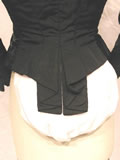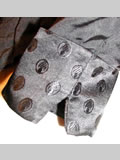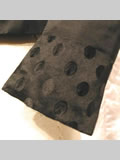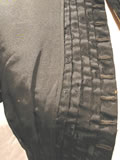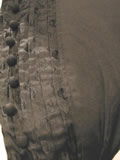This c. 1885 bodice is made of black silk faille with an accent fabric of black on black silk jacquard polka dots. The faille is flat-lined to a brown silk twill. The bone casings are made of this same twill fabric. As was popular in the mid to late-1880s this bodice ends in a point at center front and has a collar referred to as an “officers collar” by sources including Blanche Payne, Greitel Winakor, and Jane Farrell-Beck in the 1992 edition of History of Costume.
Figure 1: Front |
Figure 2: Back |
 |
 |
Bodice
This bodice opens at center front. The panels that make center front are the polka dot jacquard that are folded into pleats that taper in width from top to bottom. The next panel wraps the body so that the side seam is actually a good deal past where the side seam would normally be and almost to the side back princess seam. This second panel has two waist darts and one fisheye dart at the waist. The fisheye dart spans the space between the second waist dart and the side seam creating a peplum appearance. There is a very small side back panel that has a lot of curve to the seams. Lastly, the body of the garment is comprised of a center back panel and pleats. The pleats are folded together and stitched at the waist of the garment with a contrast fabric, as can be seen in Figure 3 below. The sleeve is a one-piece sleeve with a cuff.
The bodice opens with 17 passamenterie ball buttons. The buttons sit on the last of 5 pleats that are on the left side of the bodice, but there is an extension piece ¾” wide that has been added to the center front after the pleats were constructed. The right side has 4 pleats and the same ¾” extension. The right extension meets the bottom edge of the pleats, whereas the left extension is ¼” shorter than the bodice. This extension seems to be an afterthought. The extensions are top stitched to the bodice by machine. Each pleat goes into the neckline averaging 3/8". By the time they reach the bottom of the bodice the pleats have shrunk to 1/8" each. The pleats do not grade down at the same rate. There is a slight curve in the pattern piece to accommodate to shape of the bust. The faille lays on top of the pleats and is top-stitched down to secure the fabric. The center front most edge is folded under with the flat-lining and they are top-stitched together. The pleats are secured by a small even running stitch to the inside.
Often in the construction of a garment a secondary fabric is flat-lined to the fashion fabric for stability, as is the case with this bodice. This means the exterior fabric was stitched by hand to a second piece of fabric, in this case brown twill, and the two fabrics were worked as one. This gives added strength and stability to the outside fabric. All of the seams of this bodice, including the armscye, are stitched by machine and finished with hand over-casting. The bone casings are the same fabric as the flat lining. There are bones on both front darts (6 1/2" and 5 3/4" long) and the side seam (7" long), which is placed about two inches back from the actual side seam. A few of the bones now stick out from their casings in part because they are cut at a rather jagged angle. The side back seam is not pressed open, but instead trimmed short and pressed away from center back with a secondary machine stitch to keep the allowance together and prevent it from fraying. The shoulder seam is set back from the natural shoulder line 3/4" at the neckline and 1 1/4" at the armscye. The seam measures 5 3/8" long. It is stitched twice, once on the stitch line and once 1/4" away as a security stitch. 3/4" of seam allowance is left at the shoulder; it was then overcast by hand as well.
Figure 3: Interior
|
 |
There are two curved darts on either side of the front of the bodice. The darts on the right side of the bodice are ¾” from the pleat furthest from center front. Comparatively, the darts on the left are 1 1/4" inches from the pleat furthest from center front. There is a fisheye dart clipped on the right side, but cut open on the left side. To help close the tight fitting bodice at the waist there is an inner tab with five wire hooks and eyes made from the flat-lining fabric. The tab measures 1 1/2"” by 3 3/4" and is stitched to the flat-lining near the first dart by machine. The bottom hook and eye is level with the fifth button from the bottom.
At the center back there are two sets of pleats, made from the faille, laying on top of each other and stitched into the side back and center back seams. The shortest pleat is 4 3/8" long and the longest is 6 1/2" long at their longest points. The pleats are lined with self-fabric with the raw edge sitting at the waist on the inside. The pleats are cleaned on the inside with a piece of the contrasting dot fabric 5/8" wide, possibly because it was thinner than the faille or for a fun touch. The interior hem is finished with a bias strip of self-fabric 2" wide.
Sleeves and collar
The sleeves are a simple one piece fitted sleeve with very little easing in the cap and no extra easing at the elbow with a small cuff, as is sometimes seen in this period, according to the authors of History of Costume. The contrasting cuff is separate and stitched onto the end of the sleeve and folded up as one unit. It is 2 3/8" long. There are no buttons at the cuff. The cuff is split 1 inch along the back seam.
The collar is made from the polka dot jacquard. It stands 1 3/8" high and is shaped to sit close to the neck. It is secured past the center front line with a hook and thread loop. The interior of the collar is comprised of self-fabric and is hand-stitched down to clean the inside neckline.
Damage
There is damage on the side back seams more so on the left side than the right, as seen in Figure 4 below. It seems to be due to fabric slippage because the flat-lining is still intact. The faille at the back of both armscyes is also starting to slip. There are small rips in the fabric on the right sleeve and small rips in both of the outside front darts. This is most likely due to stress. This garment was most likely very tightly fit and worn over a tightly fitting corset.
Figure 4: Seam Deterioration |
Figure 5: Interior Stains |
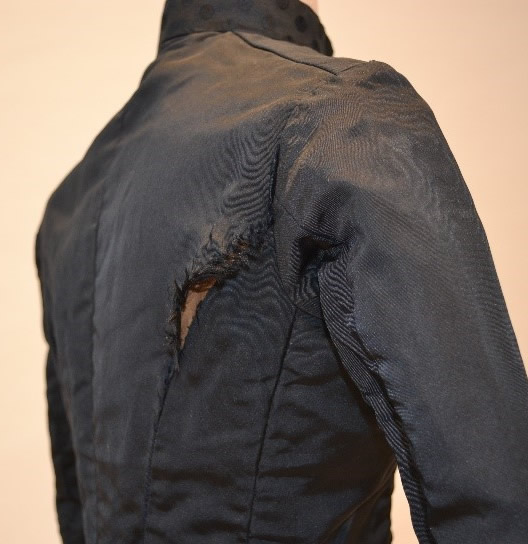 |
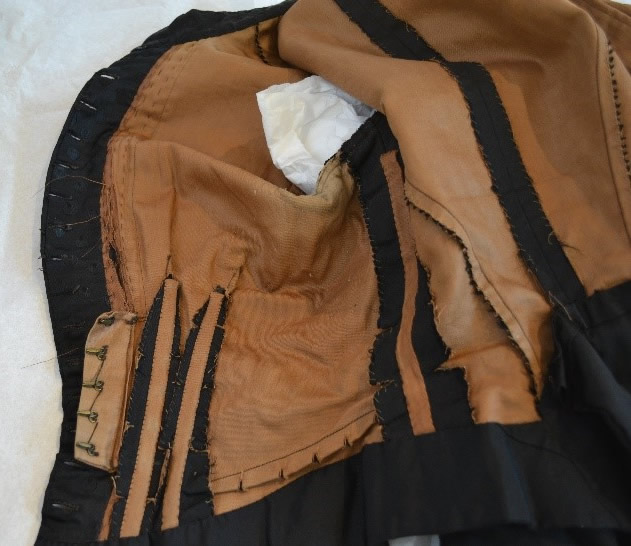 |
On the inside of the bodice the flat-lining has started to rip where the pleats have been stitched in place, as can ben seen in Figure 5 above. This is far more prevalent on the right than the left side of the bodice. The fisheye dart on the right side has been clipped four times, but on the left side the folded edge has been cut away altogether and therefore has much more fraying. There are stains at the armscyes. Several bones are missing from the casings.
© Erin R. Abbenante, 2016


